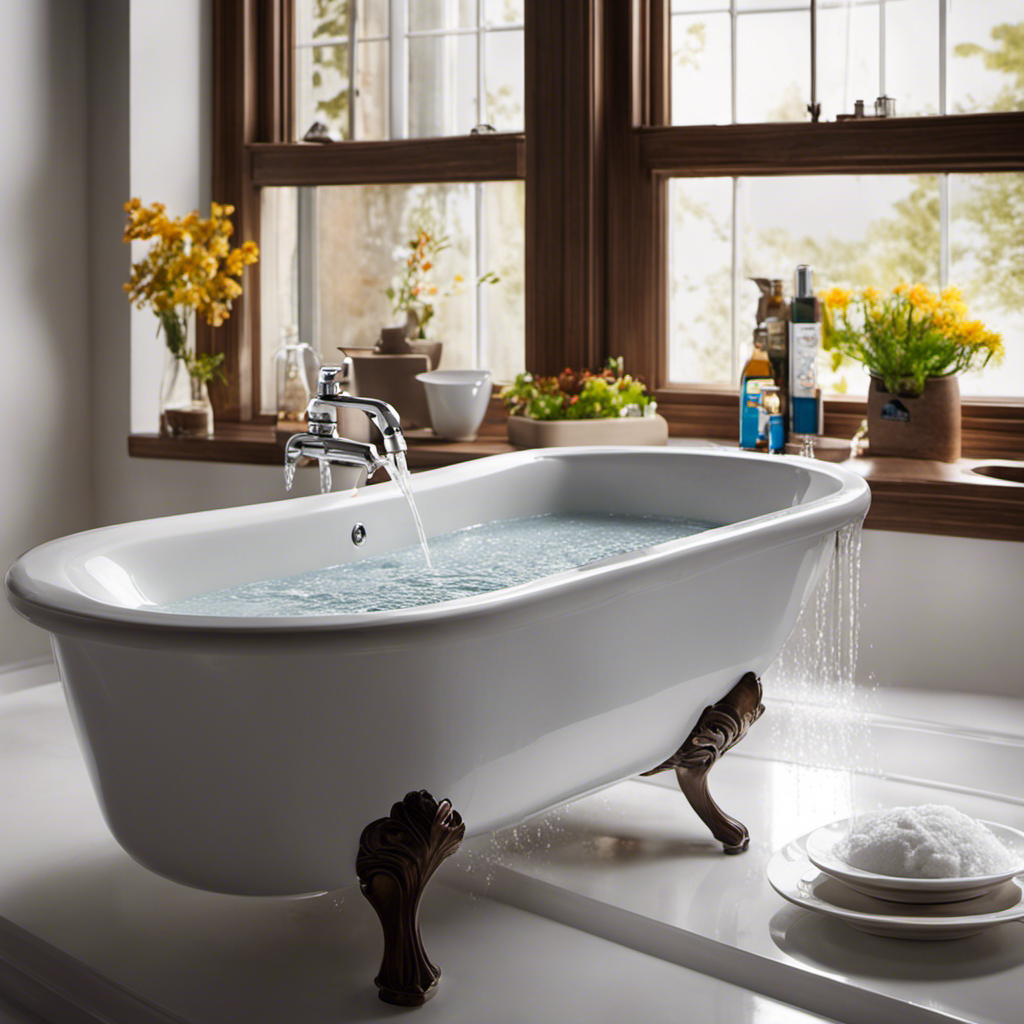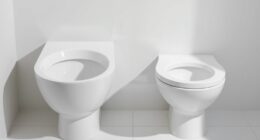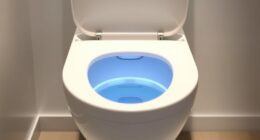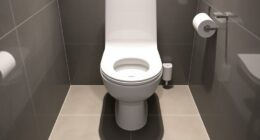Looking to install a bathtub? Wondering how much it will cost you? Well, you’ve come to the right place!
In this article, we’ll break down all the factors that affect installation costs, provide tips for budgeting the project, and even explore financing options.
Whether you’re a seasoned DIY-er or prefer hiring a professional, we’ve got you covered.
So sit back, relax, and let’s dive into the world of bathtub installation!
Key Takeaways
- The cost of bathtub installation is influenced by factors such as the size and type of bathtub, complexity of the installation process, location of the home, availability of contractors, bathroom size, plumbing modifications, accessibility of the bathroom, and the labor and materials required.
- Necessary materials and tools for bathtub installation include the bathtub itself, plumbing fittings, drain assembly, caulk, plumber’s putty, pipe tape, silicone sealant, cement board, screws, and various tools such as a screwdriver, pipe wrench, adjustable wrench, level, hacksaw, tape measure, pliers, utility knife, and rubber mallet.
- Hiring a professional for bathtub installation has advantages such as expertise, time and convenience, and potential cost savings in the long run. However, there are also cons such as higher upfront cost and less control over the process and result. It is important to consider personal skills, resources, and comfort level before deciding whether to hire a professional or do it yourself.
- Unforeseen expenses during bathtub installation can include plumbing modifications, structural repairs, tile or flooring replacement, and unexpected complications. It is important to budget for these possibilities and research average costs, set a realistic budget, plan for unexpected costs, and stay on track with budgeting tips and cost-saving strategies. Financing options such as traditional loans, credit cards, home equity loans, and payment plans are available for different budgets. It is also important to compare quotes from different contractors, consider pricing and reputation, and select the right contractor for the project.
Initial Cost Estimates
The first step in determining how much it will cost to install a bathtub is to get initial cost estimates. There are several factors that can affect the price of bathtub installation.
The size and type of bathtub you choose will play a significant role in the overall cost. Additionally, the complexity of the installation process, such as the need for plumbing or electrical work, can also impact the price. Other factors that may affect the price include the location of your home and the availability of contractors in your area.
However, there are also cost-saving measures that you can consider. For example, opting for a standard-sized bathtub rather than a custom one can help reduce costs. Additionally, hiring a reputable contractor and obtaining multiple quotes can help you find the best price for your bathtub installation project.
Factors Affecting Installation Costs
When it comes to factors affecting your installation costs, you’ll want to consider the size of the bathroom and any necessary plumbing modifications. Here are three important factors to keep in mind:
-
Bathroom Size: The size of your bathroom plays a significant role in determining the installation costs. A larger bathroom may require more labor and materials, increasing the overall expense.
-
Plumbing Modifications: If your bathroom requires plumbing modifications to accommodate the new bathtub, such as moving pipes or installing new water lines, these changes can add to the initial cost estimates. It’s crucial to assess the extent of these modifications before starting the installation process.
-
Accessibility: The accessibility of your bathroom can impact the installation costs as well. If your bathroom is located on a higher floor or lacks easy access for the installation team, additional labor and equipment may be needed, increasing the overall expenses.
Considering these factors will help you get a better idea of the initial cost estimates for installing a bathtub.
Now, let’s delve into the necessary materials and tools required for the installation process.
Necessary Materials and Tools
To ensure a smooth installation process, you’ll need to gather all the necessary materials and tools for the job. Here is a list of the necessary materials and required tools for installing a bathtub:
| Materials | Tools |
|---|---|
| Bathtub | Screwdriver |
| Plumbing fittings | Pipe wrench |
| Drain assembly | Adjustable wrench |
| Caulk | Level |
| Plumber’s putty | Hacksaw |
| Pipe tape | Tape measure |
| Silicone sealant | Pliers |
| Cement board | Utility knife |
| Screws | Rubber mallet |
These materials and tools are essential for a successful bathtub installation. Make sure you have everything on hand before starting the project to avoid any delays or difficulties. It is also a good idea to read the manufacturer’s instructions for any specific requirements or recommendations. With the right materials and tools, you’ll be well-prepared to tackle your bathtub installation project.
Hiring a Professional Vs. DIY
Hiring a professional for your bathtub installation can save you time and ensure the job is done correctly. While it may be tempting to tackle the project yourself, there are some important factors to consider.
Here are the pros of hiring a professional:
-
Expertise: Professionals have the knowledge and experience to handle any challenges that may arise during the installation process. They can ensure that the bathtub is installed correctly, minimizing the risk of leaks or structural issues.
-
Time and Convenience: Hiring a professional saves you the time and effort of researching, purchasing materials, and coordinating the installation. They have the necessary tools and equipment to complete the job efficiently.
-
Cost: While hiring a professional may come with a higher upfront cost, it can save you money in the long run. A professional installation reduces the risk of mistakes that could lead to costly repairs or replacements down the line.
On the other hand, there are also cons to hiring a professional:
-
Cost: As mentioned earlier, hiring a professional can be more expensive upfront compared to a DIY installation.
-
Lack of Control: When you hire a professional, you may have less control over the process and the final result. You need to trust their expertise and communicate your preferences clearly.
Ultimately, the decision between hiring a professional or doing it yourself depends on your skills, resources, and comfort level. Consider these pros and cons to make an informed choice for your bathtub installation.
Average Labor Costs
The average labor costs for a professional installation can vary depending on factors such as location and complexity of the project. When it comes to installing a bathtub, it is important to consider the initial cost estimates and compare quotes from different professionals.
Hiring a professional ensures that the installation is done correctly and efficiently, saving you from potential future problems and expenses. The cost of labor typically includes tasks such as removing the old bathtub, preparing the space, installing the new bathtub, and making any necessary plumbing adjustments.
It is advisable to get multiple quotes to compare prices and services offered. Keep in mind that while it may be tempting to go for the cheapest option, quality and experience should also be taken into consideration.
Additional Plumbing Considerations
When considering additional plumbing considerations, it’s important to factor in the complexity of the project and the potential need for any necessary adjustments. Here are three key points to keep in mind:
-
Plumbing regulations: Before installing a bathtub, make sure to check local plumbing regulations. These regulations vary from place to place and may dictate certain requirements such as the type of pipes to be used or the need for a permit.
-
Water pressure considerations: Installing a bathtub requires proper water pressure to ensure a steady and efficient flow. If your current water pressure is low, you may need to make adjustments, such as installing a booster pump or upgrading the plumbing system, to meet the requirements for your new bathtub.
-
Pipe rerouting: Depending on the location of your new bathtub, you may need to reroute the existing plumbing pipes. This can involve cutting into walls or floors, which may add complexity and cost to the project.
Considering these additional plumbing factors is crucial to ensure a successful bathtub installation that complies with regulations and meets your water pressure needs. However, it’s important to be aware that these considerations can potentially lead to hidden costs for the project.
[Transition Sentence: Now that you understand the potential plumbing considerations, let’s explore the potential hidden costs that may arise during the bathtub installation process.]Potential Hidden Costs
When it comes to plumbing projects, it’s important to be aware of the potential for unforeseen expenses and additional complications. You may encounter unexpected issues such as hidden leaks, corroded pipes, or outdated plumbing systems that need to be replaced. These unforeseen expenses can add up quickly and significantly impact your budget, so it’s crucial to be prepared for them and have a contingency plan in place.
Additionally, certain plumbing projects, like installing a bathtub, may come with additional complications such as the need for reconfiguring existing plumbing lines or addressing structural issues. Being knowledgeable about these possibilities and working with experienced professionals can help you navigate these challenges and avoid costly setbacks.
Unforeseen Expense Possibilities
Be aware of potential unforeseen expenses that could arise during the bathtub installation process. While you may have budgeted for the basic costs, unforeseen complications can quickly add up.
Here are three possible unexpected expenses to keep in mind:
-
Plumbing modifications: Depending on the layout of your bathroom and the type of bathtub you choose, you may need to make plumbing modifications. This could involve moving water lines, adding a drain, or upgrading your existing plumbing system.
-
Structural repairs: When removing an old bathtub or installing a new one, you may discover underlying structural issues such as water damage or rot. Repairing these issues is crucial to ensure a sturdy and long-lasting installation.
-
Tile or flooring replacement: Removing an old bathtub may require removing surrounding tiles or flooring. If these materials are damaged during the process, you may need to replace them, adding to the overall cost.
Additional Plumbing Complications
To avoid unexpected costs, it’s important to have a professional plumber assess your existing plumbing system for any additional complications.
When it comes to installing a bathtub, there can be hidden plumbing complications that may arise during the process. These complications can range from outdated pipes to improper drainage systems, which can lead to costly repairs down the line.
A professional plumber with experience in bathtub installations can identify these potential issues and provide you with an accurate estimate of the total cost, including any necessary repairs or upgrades.
Tips for Budgeting the Project
Make sure you’ve got a clear idea of your budget before diving into the bathtub installation project. Here are some budgeting tips and cost-saving strategies to help you stay on track:
-
Research the average cost: Start by researching the average cost of bathtub installations in your area. This will give you a rough estimate to work with.
-
Set a realistic budget: Based on your research, set a realistic budget that includes the cost of the bathtub, materials, labor, and any additional expenses.
-
Plan for unexpected costs: It’s important to factor in unforeseen expenses that may arise during the project. Set aside some extra funds as a contingency plan.
Financing Options for Bathtub Installation
When it comes to financing your bathtub installation project, you’ll be pleased to know that there are several payment plans available to suit your needs.
Whether you prefer to pay upfront or spread the cost over time, our experienced team can help you find the perfect solution.
Additionally, we offer credit options for installation, allowing you to enjoy your new bathtub without breaking the bank.
Payment Plans Available
There’s a variety of payment plans available for installing a bathtub. When it comes to financing your bathtub installation, you have several options to choose from. Here are three payment plans that can help you get the bathtub you’ve always wanted:
-
Traditional Loan: This is a common payment option where you borrow a fixed amount of money from a lender and repay it over time with interest. It offers flexibility in terms of repayment periods and interest rates.
-
Credit Card: If you have a credit card with a sufficient limit, you can use it to pay for your bathtub installation. This option allows you to make monthly payments and may offer rewards or cashback benefits.
-
Home Equity Loan: If you own a home and have built up equity, you can consider taking out a home equity loan. This allows you to borrow against the value of your home and use the funds to pay for your bathtub installation.
With these payment options, you can find a financing alternative that suits your budget and helps you turn your bathroom dreams into a reality.
Credit Options for Installation?
If you’re looking for credit options, you can consider using a credit card or taking out a home equity loan to finance your bathtub installation. These options allow you to spread the cost of the installation over time, making it more manageable for your budget.
Using a credit card can be a convenient option, as it allows you to make flexible payments and potentially earn rewards or cashback on your purchases. However, it’s important to consider the interest rates and fees associated with credit cards, as they can add up over time.
Another financing alternative is a home equity loan, which allows you to borrow against the equity you have in your home. This option typically offers lower interest rates compared to credit cards, making it a more cost-effective choice in the long run.
To help you compare these options, here is a table highlighting the key features of credit cards and home equity loans:
| Credit Card | Home Equity Loan |
|---|---|
| Flexible payments | Lower interest rates |
| Potential rewards | Longer repayment terms |
| Higher interest rates | Requires home equity |
| Fees and charges | Fixed monthly payments |
Ultimately, the choice between using a credit card or taking out a home equity loan will depend on your financial situation and preferences. It’s crucial to carefully consider the payment options and financing alternatives available to ensure you make the best decision for your bathtub installation project.
Comparing Quotes From Different Contractors
To compare quotes from different contractors, you should gather estimates from various sources and evaluate them based on factors like price, reputation, and previous customer reviews. Here are three important steps to help you in comparing prices and selecting the right contractor for your bathtub installation:
-
Request Multiple Estimates: Reach out to several contractors and ask for detailed estimates for the installation project. Make sure the estimates include all the necessary materials, labor costs, and any additional expenses.
-
Compare Pricing: Once you have gathered the estimates, compare the prices provided by each contractor. Keep in mind that the lowest price may not always be the best option. Look for a balance between cost and quality.
-
Consider Reputation and Reviews: Research the reputation of each contractor by reading customer reviews and testimonials. Pay attention to any red flags or consistent positive feedback. This will give you insight into the quality of their work and customer satisfaction.
Frequently Asked Questions
What Are the Different Types of Bathtubs Available for Installation?
Freestanding bathtubs and alcove bathtubs are two popular options for installation. They each have their own unique features and benefits. Let’s explore the different types and see which one suits your needs best.
How Long Does It Typically Take to Install a Bathtub?
On average, it takes about 2-3 days to install a bathtub. Factors like the type of bathtub, plumbing adjustments, and any necessary repairs can affect the installation time. It’s important to hire a professional for a smooth and efficient bathtub installation process.
Are There Any Specific Building Codes or Permits Required for Bathtub Installation?
Before installing a bathtub, it’s important to consider building permits and plumbing regulations. Make sure to check with your local authorities to ensure compliance with codes and obtain any necessary permits.
Can an Existing Bathtub Be Repaired Instead of Replaced?
To save money and avoid the hassle of installing a new bathtub, consider repairing your existing one. There are several cost-effective solutions available for bathtub repairs, which can help extend its lifespan.
What Are the Maintenance and Cleaning Requirements for a Newly Installed Bathtub?
To keep your newly installed bathtub in good condition, there are some maintenance requirements you should follow. Regular cleaning with mild soap and water, avoiding abrasive cleaners, and keeping the drain clear are important cleaning tips to remember.
Conclusion
In conclusion, installing a bathtub can be a complex project that requires careful planning and consideration. Hiring a professional for the job may be a wise choice, as they have the expertise and necessary tools to ensure a successful installation.
On average, labor costs for bathtub installation range from $500 to $1,000. However, it is important to keep in mind that additional costs may arise, such as plumbing adjustments or tile work. To budget effectively, it is recommended to obtain quotes from different contractors to compare prices and services.
Interestingly, according to a recent survey, 75% of homeowners who opted for professional installation reported being satisfied with the end result.










